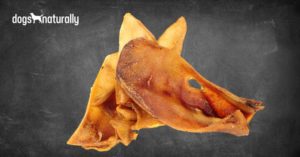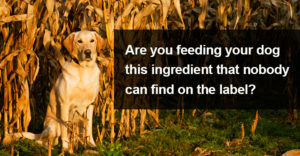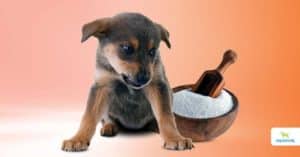A Cornell University study says … yes, there is. In 2021, the study reported that processed foods being fed to dogs is causing liver damage at an alarming rate … because there’s too much copper in dog food.
And yet this information hasn’t sounded the alarm bells like the melamine scare, or toxic levels of vitamin D in dog food, or the grain vs grain-free dog food debate.
Here’s why you should be concerned about the high levels of copper in dog food.
Copper In Dogs
Copper is an essential trace mineral … which means that your dog can’t make it and needs to get it in his diet. Copper is involved in activating enzymes that run pretty much every metabolic function in your dog’s body. Plus it helps build red blood cells and grows healthy connective tissue, skin and coats.
In 1929 researchers looked at how much copper was stored in the dog’s liver and on average they found about 10 micrograms (mcg) per gram. In 1982, they looked again and this time the average was a massive 200 mcg per gram. Then in 1995 when they looked again it was up to 453 mcg per gram.
A more recent study compared copper in feral dogs to healthy dogs raised in a laboratory eating commercial dog food. They found that the lab dogs averaged 472 mcg per gram while the feral dogs had just 152 mcg. So the lab dogs had three times more copper. And because they were in a controlled environment, there’s only one explanation about how that happened … the dog food they ate.
Dogs need very little copper, and copper deficiency in dogs is really rare. And yet this research shows the amount of copper in dog’s livers is rising with time … and it more than doubled in just 13 years.
Copper In Dog Food Diets
Researchers looked into it further and they found that the rise in copper levels wasn’t linked to breed specific disease. But it was linked to how much copper was in the diet, and they found high amounts of copper in commercial dog foods.
One of the authors of the Cornell study found that 58% of liver biopsies had inflammatory liver disease and more than 400 mcg per gram of copper concentration. So it’s possible that more than half of dogs are affected by excess copper.
And this is a big problem.
Copper Toxicity In Dogs
When your dog gets too much copper it’s called copper toxicity. Excess copper accumulates in the liver and causes inflammation and damage, and that scars the liver. Over time it causes liver failure and even death.
The biggest problem with this kind of liver inflammation is most dog owners have no idea it’s happening because dogs don’t show symptoms until the damage is really advanced … and then it can be too late.
The only early sign is if you have blood work done … you might see changes in your dog’s ALT levels. ALT are enzymes contained within liver cells. When levels are increased in the blood, it means that the enzymes have leaked out of the liver cells due to cell damage.
Signs Of Liver Damage in Dogs
By the time you see signs of copper poisoning, liver damage can be fairly serious.
- Abdominal swelling
- Diarrhea
- Loss of appetite
- Jaundice – yellowing of the skin or whites of the eyes
- Increased thirst
- Vomiting
RELATED: A guide to elevated liver enzymes in dogs …
So how did it get that high?
Standards For Copper In Dog Food
AAFCO (the Association Of American Feed Control Officials) sets nutrient guidelines for pet food manufacturers.
In most cases, AAFCO’s nutritional requirements are minimum amounts to ensure pets get the minimum amount of nutrients they need to survive without obvious signs of disease. There are no optimal levels from AAFCO, but occasionally maximum levels are provided for a handful of nutrients.
How Much Copper Is Toxic To Dogs?
The minimum copper requirement for adult dogs is 7.3 mg/kg and 12.4 mg/kg for puppies … but dog food makers are free to add as much copper as they want as long as they meet the minimum. In 2007, AAFCO removed its safe upper limit for copper, which was 250 mg/kg in the dry diet.
Increased Copper In Dog Food
So the question is … why are pet food makers putting so much copper in their food and why is it increasing?
Most pet foods are heated several times, then extruded and then sit in bags on shelves for months or years … which leads to a lot of nutrient loss. Cooking foods can destroy about 40% of the copper as well as other nutrients.
So pet food makers add a standard premix. These are lab-made vitamins and minerals (usually from China) meant to replace the nutrients destroyed through processing … to meet AAFCO standards.
There are few maximum limits, so they can put as much as they want in their food and this artificially makes the food look more nutritious. That’s why most dog foods have more chemical names on the label than food. So even if some of the vitamins and minerals in the food are sufficient (like copper), they get topped up by this premix.
So these premixes are a definite problem … but that’s not the only issue.
AAFCO Changed The Type Of Copper In Dog Food
About 15 years ago most premixes used an inorganic form of copper called copper oxide which has low bioavailability in dogs. AAFCO recommended a much more bioavailable form of copper like copper sulfate.
Since then a lot of premium foods have used even more bioavailable organic forms of copper like copper chelate so every year there’s more and more copper in dog foods … and more copper in dogs’ livers.
It was surprising that AAFCO made this change despite the following facts:
- Dogs need very little copper to maintain health
- There were no reports of copper deficiencies in dogs
- Copper in dogs’ livers was rising
- There were no peer-reviewed studies examining copper requirements
- There was no AAFCO re-evaluation of the minimum copper requirement
As well as using the more bioavailable type of copper, manufacturers are using more ingredients that increase copper in dog food.
Copper-Rich Ingredients In Dog Food
Here are some ingredients rich in copper in commercial dog foods:
- Liver
- Fish and seafood
- Chickpeas
- Sweet potatoes
- Sunflower seeds
- Kale
A lot of grain-free foods use chickpeas and sweet potatoes as a source of starch … plus a mineral premix.
How Much Copper Should There Be?
Pet foods are not required to reveal the amount of copper in the Guaranteed Analysis on the label. So if you want to know if it’s a low copper dog food, you’ll need to call the manufacturer to find out.
Look for an amount of copper that’s somewhat close to the minimum levels of 7.3 mg/kg for adults or 12.4 mg/kg for puppies.
If your dog food maker can’t tell you how much copper is in the food, don’t buy that brand. Find a company who’ll tell you about the copper levels in their food and don’t risk your dog eating toxic levels of copper that can seriously harm him.
References:
- Center Sa, et al. Is It Time To Reconsider Current Guidelines For Copper Content In Commercial Dog Foods? Journal Of The American Veterinary Medical Association. 2021; 258:357-364.
- Strickland JM, Buchweitz JP et al. Hepatic copper concentrations in 546 dogs (1982-2015). J Vet Intern Med. 2018 Nov;32(6):1943-1950.









